Lords of the Fallen Review
Okay, let’s make a deal. Lords of the Fallen is a Soulsborne variant, so there is no way around the comparisons I’m going to have to make to Dark Souls and Bloodborne. You may be tired of hearing “it’s like Dark Souls”, so I will do my best to keep comparisons at a low volume, and in exchange, you do not get mad at me and send me hate mail over the comparisons I do have to make. Deal? Let’s get into it.

Lords of the Fallen starts off in a very familiar manner — a hero of the world is unable to carry their burden (in this case, a magical lamp) any longer, and tosses it away. It rolls around and eventually finds its way into your prison, where you collect it, prompting you to make your character. We’ll get into the lamp (officially known as the Umbral Lamp) in a minute, because this thing is what eventually whittled away my interest in the game.
Creating a character follows all of the same beats of Dark Souls note for note — you have eight character classes, each with different stat builds and gear. Unlike in Souls games, however, you can’t examine the gear or items to determine what they do, which essentially forces you into a guessing game: what does the red sand item on the Udirangr Warwolf class do? What do the three red rocks that the Mournstead Infantry owns affect? I tried everything, on both controller and keyboard, to try and figure out a way to examine these items, to view even just a description, but ultimately couldn’t, leaving me pretty sour on the whole process. Eventually, I settled on the Pyric Cultist, which is this game’s version of a Pyromancer.
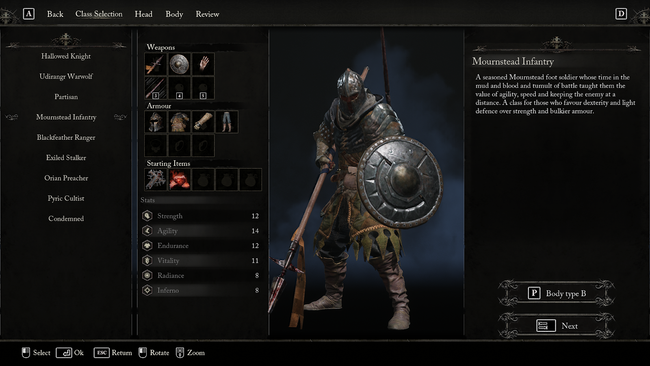
The early game of Lords of the Fallen is actually quite fun — you have a decrepit dungeon to explore, enemies are spaced equally around to teach you the various Souls-style tutorials, and you get to engage with the unique mechanic this game has, the Umbral Lamp, very briefly. The environments are quite nice to look at, and everything just feels so familiar, in a good way. This feeling lasted pretty much until after the first major boss (The Hushed Saint), so let’s talk about the good before we get into the bad.
Exploration and presentation in Lords of the Fallen genuinely felt like other Souls games to the point that a more casual fan of the genre would be hard-pressed to determine which is which. There are environments with a heavy emphasis on verticality. There are hidden recesses for enemies to surprise you from. There are mimics (and they are horrifying, and annoying!) There are waist-high water hazards that you have to fight in. Hell, there’s even plenty of bare feet camera shots! Everything a Souls game has, this has too.
The hub, Skyrest Bridge, feels like Roundtable Hold or Dark Souls 3’s Firelink Shrine — with plenty of friendly faces to help you upgrade your gear, sell stuff to you, and wax poetic about the plight of the Lampbearer (that’s you, by the way.) There are Faith and Intelligence builds (Radiance and Inferno) as well as your standard Strength, Dexterity (Agility), Endurance and Vitality stats, allowing you to build a magic caster, wield a massive hammer, or shoot a volley of arrows off. Every weapon scales off of a stat, so getting an appropriate weapon that scales off your primary stat (or stats) is important. So, yeah, Dark Souls. I’m not doing a very good job of trying to steer away from the comparisons, but thankfully, this is where the similarities end.
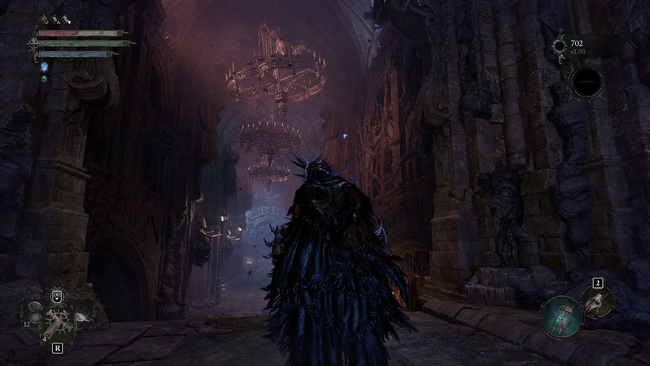
We danced around the Umbral Lamp earlier, so let me expand on that. The Umbral Lamp is Lords of the Fallen’s central mechanic. When you hold the Lamp in front of you, you can gaze into the Umbral Realm and see an alternate world. This is actually a cool feature — iron bars blocking your way? Peer into the Umbral Realm and you’ll find that the bars no longer exist, allowing you passage. Unable to proceed due to a death pit? Whip out the Lamp and take a peek — terrain might just appear before your eyes. The ability to modify the environment by phasing in and out of different states is extremely cool, and the Umbral Realm is equal parts terrifying and wonderful to look at. The Lamp also grants you an “extra” life — if you die in Axiom (the real world), you will instantly respawn in the Umbral Realm, albeit at half-health.
However — and if I could resize that word to size 100 font I would — the Umbral Realm is also the worst part about this game. Sometimes in order to proceed, you have to Rift into the Umbral, phasing your character inside the Umbral Realm. In the Umbral Realm, in addition to dealing with your regular enemies, you also have to deal with the Umbral enemies. Zombies will spawn endlessly, and while they often don’t have a lot of health, they do not stop coming. This eats up your time tremendously if every few feet you have to stop and deal with yet another one of these respawning mooks — and you do have to deal with them, because they will chase and surround you. They still hurt, after all.
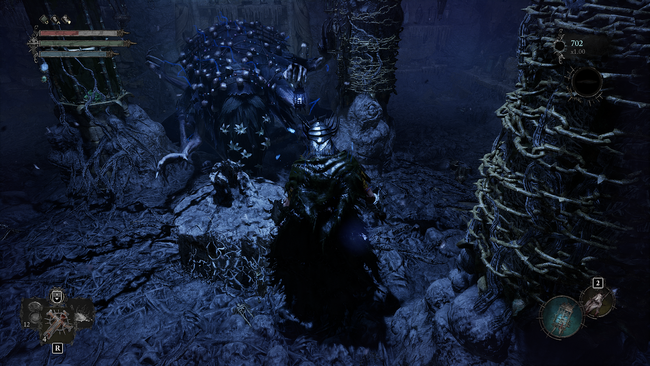
And yeah, you have a timer. Stay in the Umbral too long and the Grim Reaper appears to murder you. I don’t know if you can kill him, because everytime he appeared, he’d chase me until I found an exit point, or he’d two-shot me. This is nothing to say of the other Umbral enemies, either — there are these Imps that always appear in groups of two or three, have way too much health, and can multi-hit you for a huge chunk of your life. Finding a window of opportunity to strike becomes a tedious round of dodge-rolling until you manage to get one slightly separated from the others, and again, these enemies are in addition to whatever normal enemy would be there. All of this combines to make traversing the Umbral Realm not just dangerous, but repellent. You have this cool realm-swapping ability and you are discouraged from using it to explore, because you are actively punished with a timer and additional difficult enemies.
Early in the game, this isn’t a problem, but once you start to hit the mid-game, the enemies start to suffer from health and density issues. There are often simply too many dudes to deal with, and for the most part, they don’t stagger easily, so I eventually just started running right past all of them until I hit the next Vestige (bonfire). You often can’t “pull” enemies from one another, as they are linked, so if you try to fire an arrow to snag a patrolling enemy, you’ll often just pull the entire group towards you.
You can parry enemies, and like any Souls game, the parry windows take some getting used to. There is no backstab, but you can deal a “grievous strike” to an enemy by reducing their posture to zero before heavy attacking. The game offers a lamp-specific combat mechanic called “Soulflay”, which allows you to rip the soul from an enemy and attack it temporarily to deal Wither damage (think temporary health from Bloodborne), but in practice, the lengthy windup, animation lock, and lack of damage made it unappealing to me. Killing an enemy with Soulflay does increase item discovery, but with the aforementioned heavy enemy density and high health values, Soulflay wasn’t all that useful.
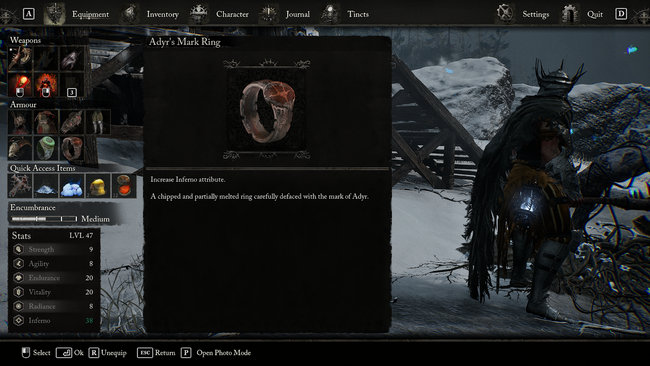
I realize that typing all of that puts me at risk of accusations that I wasn’t engaging with the RPG mechanics properly, so let me clarify that: yes, I was using an appropriately scaled weapon for my main stat, and yes, I was upgrading that weapon and slotting the appropriate gems. It is entirely possible that I just needed to “git gud”, but I genuinely felt that the non-boss enemies often had way too much health, and there were simply too many of them, to be worth engaging.
Bosses, on the other hand, did not have this issue (until Spurned Progeny, at least). Each felt fun and fair in the sense that I felt like I was making progress each attempt I made. Pieta and The Hushed Saint were extremely interesting bosses with a relatively normal learning time, while Spurned Progeny took a few hours for me to beat due to his high health values and learning his attack animations, which have odd windups. In short, however, the bosses were fun and interesting puzzles to solve.
There is an invasion mechanic, and I did get invaded a handful of times.There are also “hotspots” for invasions — I found myself getting invaded somewhat often in Lower Calrath, for example — and naturally, if you’re near a Vestige, you cannot get invaded. You can also use specific items to disable matchmaking for the life you’re on. You can summon NPC allies, but I didn’t use this mechanic during my playthrough (except once, where the NPC didn’t do much to the boss and left me to die.)
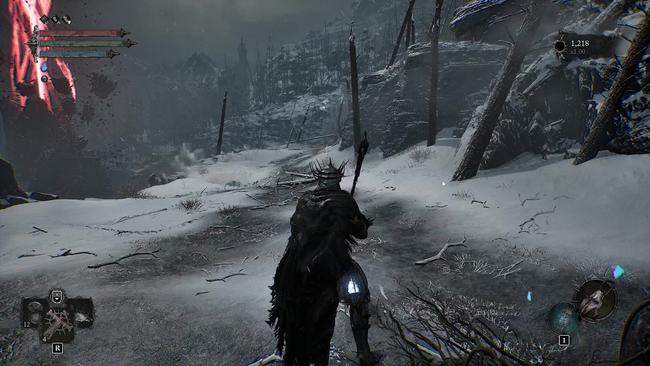
Story-wise, the game does a good mixture of active and passive storytelling — the world of Mournstead is terrifying, and the lore entries on the Vestiges you unlock are quite good to read through. Items have story bits in them, but for many items you are required to have a specific Radiance or Inferno stat value in order to unlock the lore, which to me feels like missing the point entirely. If I’m an Inferno character, how am I going to read the lore of the Radiance items? It’s a shame because the story that I could read was quite interesting, but it doesn’t feel great to be locked out from lore pieces purely based on my build.
In terms of PC performance, I tested the game on both an SSD and an HDD, and naturally, a SSD is the preferred place to install the game to. I should note that if you were planning on playing from a HDD, however, you may wish to simply invest in a SSD instead. Not only does the game outright warn you that playing from a HDD will result in hitches, I had several crashes in specific regions (like Lower Calrath) Outside of those crashes, however, the game ran relatively well, with only minor framerate drops in specific circumstances and areas. Nothing quite like the original Blighttown in terms of performance, to be sure.
So, is the game difficult? A lot of hay gets made over Souls games and their difficulty — many internet cretins have championed their “god-gaming” skills over achieving Level 1 clears, or by creating PvP montages, for example. I’m one of those cretins — there’s footage somewhere of me doing Dark Souls Four Kings at level 1, and I think the Fume Knight fight in Dark Souls 2 is fine, actually — but even I had trouble with Lords of the Fallen. Not by any self-imposed difficulty restriction, but instead through the tedious-feeling normal play. There is a New Game+ that increases the difficulty even further, but after the slog of a Normal Mode playthrough, I genuinely couldn’t be bothered.
Lords of the Fallen is not a bad game by any stretch of the imagination. It has a well-crafted world, with interesting stories and plenty of player customization on offer. However, it’s tethered to a frustrating central mechanic that discourages exploration, the lifeblood of any Souls-like in my opinion, and falls into the trap of thinking that higher difficulty means more enemies with too much health. With some patching, this game could be extremely good, but based on its current form, I ultimately found it to be a frustrating exercise in someone copying the homework of a different game, but changing things ever so slightly — just enough for you to not notice at first glance, but with any scrutiny, noticing that it’s wrong.